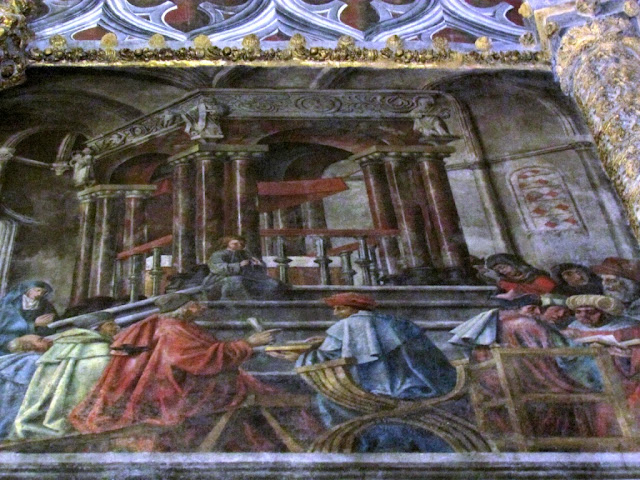TOMAR
GPS: N 39.60353; W 8.41880
The city of Tomart has several historical monuments, including the Convent of Christ, declared a World Heritage Site.
It is the seat of a municipality with an area of 351.2 km² and 40 677 inhabitants (2011), subdivided into 11 parishes. The municipality is limited to the north by the municipality of Ferreira do Zêzere, to the east by Abrantes, to the south by Vila Nova da Barquinha, to the west by Torres Novas, and to the northwest by Ourém.
The city is crossed by the Nabão River, which is a tributary of the Zêzere River, being included in the Tagus hydrographic basin, the largest river in the Iberian Peninsula.
It is located in one of the most fertile areas of mainland Portugal for the production of olive oil, figs, or vines for example.
Former headquarters of the Order of the Templars, Tomar is a city of great charm, for its artistic and cultural wealth. The maximum exponent is in the Convento de Cristo, one of the most important works of the Renaissance in Portugal.
Whatever the reason for visiting the city, going up to the Templar castle and discovering the monumental work of the Convento de Cristo is essential.
It is worth seeing the Convent carefully to discover some gems, such as the representations on the Renaissance portal, the particular symbolism of the Manueline Window of the Chapter Room, the architectural details of the Main Cloister, and the dependencies linked to the Templar rituals.
From the Convent, we can walk down the Mata dos Sete Montes to the historic center. Going down the road, we see the Chapel of Nossa Senhora da Conceição, a small Renaissance jewel, the work of the Portuguese João de Castilho who also worked at the Convent.
Next, you have to visit Tomar. The oldest, medieval urban area is organized in a cross, oriented by the cardinal points and having a convent at each end. Praça da República, with the Mother Church dedicated to São João Baptista, marks the center, with the hill of Castelo and Convento de Cristo to the west. In the streets around you can find traditional shops and the oldest cafe where you can enjoy the delights of local pastries.
To the south, the Convento de São Francisco, where you can currently visit the curious Museum of Matches and, to the north, the former Convento da Anunciada.
Parque do Mouchão is a cool place, where you can see the Roda do Mouchão, a wooden hydraulic wheel. It is an ex-libris of the city and evokes the times when the mills, mills, and cultivation areas along the river contributed to Tomar's economic prosperity.
But there are also reasons to stroll nearby, such as Castelo de Bode, one of the largest reservoirs in the country, where you can take a quiet cruise with lunch on board or opt for a variety of water sports. Also, like the small islet of the Tagus River where the Castle of Almourol is located or the riverside town of Dornes.




HOW TO GET THERE
BY TRAIN :
METRO STATION "SANTA APOLÓNIA" - CONECTION WITH RAILWAY STATION " SANTA APOLÓNIA". OR IN METRO AND RAILWAYSTATION "ORIENTE"
CHURCH OF SANTA MARIA DOS OLIVAIS
CHURCH OF SANTA IRIA
CHUCH OF MISERICÓRDIA
MUSEUM OF MATCHES
Curious museum with 43,000 copies of matchboxes from 117 Countries
ATELIER OF TILE
In the same building and right in front of the museum of matches there is an interesting workshop tile. It is open to visitors and you can buy up tiles.
CONVENT OF CHRIST (WORLD HERITAGE)
 |
| CONVENT OF CHRIST SEEN FROM TOMAR |
By Motorway: from Lisbon - A1, to km 93, exit at A23 for Torres Novas, then on IC9 to exit sign for Tomar on N 110. (shorter route - south access).
By National Highway: from Leiria - N 113 / IC9; From Coimbra - EN 110.
Train: Several daily trains between Lisbon and Tomar, via Entroncamento. About 2 hours away.
In the city: At the roundabout of Praceta Alves Redol, take the west direction, by Av. Dr. Cândido Madureira and, in the end, turn right, going up Av. Dr. Vieira Guimarães which ends in the front parking lot near the Castle of the Templars.
On foot, in the city: Access Praça da República and, behind the Town Hall Building, climb the Calçada de S. Tiago to the parking lot.
Access the Convent by the Castle of the Templars.
AQUEDUCT OF PEGÕES ( TOMAR )
Its construction started in 1593 and was completed in 1614.
The aqueduct has 58 full round arches, in its highest part, on 16 pointed arches supported on pillars. Its maximum height is 30 meters. At the ends, there are vaulted houses, with a large sink in the center for decanting the water.

































































































































































































































































































































